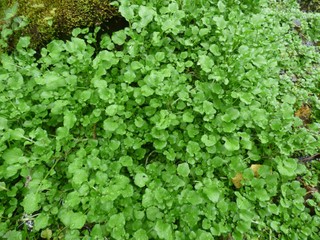How to grow and care for watercress indoors

Popular in the diet of Roman soldiers centuries ago, watercress is making a fast and furious resurgence in today’s homes and diets. Known for its nutritional advantages this water-loving perennial is easy to grow and adapts well to being grown in containers indoors.
Background info
Watercress, also known as yellowcress or garden cress, is a member of the cruciferous family, related to kale, broccoli, and brussel sprouts. Cruciferous vegetables and herbs are unique as they contain sulfur-containing compounds called glucosinolates (β-thioglucoside N-hydroxysulfates) that impart a pungent aroma and characteristic spicy/bitter taste. The name, cruciferous, of this family of vegetables came from the four equal-sized petals found in its flowers that formed a cross-like or crucifix shape.
It’s naturally found growing in gently running water forming dense mats. Natural springs, bogs, streams, and river banks are the most common locations. Unlike most other plants, the roots of watercress prefer to be waterlogged; watercress is also more prevalent in slightly alkaline waters.
Uses for Watercress
Like many other popular herbs, watercress is typically used for culinary purposes.
- It’s peppery taste from the glucosinolates make it a popular addition to salad greens. A small amount adds a large punch of flavor, making it a great alternative to salt.
- In Europe, watercress sandwiches are a staple fare during traditional tea time.
- The peppery bite works well as a garnish for soups.
- Some people add it to smoothies in place of spinach or kale to increase the nutritional value.
- It can also be used any way cultivated mustard is used.
 Watercress and chive on toast. Yum!
Watercress and chive on toast. Yum!
Health benefits
Regardless of its flavorful nature, some people are implementing watercress into their diets because of the amazing health benefits it offers.
In order to gauge how healthy a food is, the Aggregate Nutrient Density Index (ANDI) was developed. The nutrient density (ratio of micronutrients and vitamins to calories) of foods places them on a scale from 0 to 1000 with higher numbers being more nutrient dense, and therefore healthier for you to consume. Watercress has a high ANDI score containing more Vitamin A, VitaminB1, VitaminB3, Vitamin C, Vitamin K, iron, potassium, and calcium than any other vegetable.
When chopped or chewed, the glucosinolates in watercress releases compounds called indoles and isothiocyanates, known to help reduce cancer risk.[1]

The enthusiast's guide to herbs
We’re proud to present our new e-book, The Enthusiast’s Guide to Herbs! Learn everything you need to know about growing and caring for herbs indoors, including in-depth info cards for the 35 most commonly grown herbs.
Click the link below to find out more!
When to grow it
Similar to other herbs, watercress can be grown indoors and harvested all year round. The flavor in the leaves is best during the cooler months of the year; it will lessen if indoor temperatures climb above 85℉ or the plant flowers.
How to grow watercress indoors
While watercress crops up on its own in areas of slightly alkaline, gently moving water, it makes the transition to growing indoors in containers fairly well if the appropriate conditions are met.
Growing conditions
Watercress plants like a shady spot to grow when indoors; they do best with approximately four hours of sunlight early in the day and then shade in the afternoon during the hottest, most intense hours of the afternoon. Place containers in a north-facing window, or on a windowsill that receives shade from a nearby tree later in the day.
Cooler temperatures are preferred over warmer conditions, as the heat affects the flavor in the foliage. Considered a cool-weather crop, watercress is perfectly content hanging out when indoor temperatures are between 60 and 70℉. Remember that these plants grow in nature in water environments that are naturally cooler.
Growing media
This is one type of plant where you’ll want to skip the potting soil if at all possible and do not use garden soil. Watercress grows best in a soilless potting mix such as vermiculite or perlite, that is then mixed with peat to increase water retention.
Commercial growers opt to grow watercress in water-based systems to mimic their indigenous growing conditions. This isn’t recommended for growing it indoors at home unless you have a system that continuously circulates fresh water through the root system.
 You can use watercress as a garnish on almost any dish to add some freshness!
You can use watercress as a garnish on almost any dish to add some freshness!
Containers
With the need to have roots constantly saturated, you have to create a dual-container system for your watercress plants.
Pick two containers slightly different in size so one can nest within the other. The smaller container needs to have drainage holes; the larger container shouldn’t have any to hold water. Place a coffee filter or paper towel in the bottom of the smaller container to keep your growing media from washing out.
Plastic containers work the best as they don’t allow water to evaporate like terra cotta or clay pots do. To find out more about which containers work best check out our article on the best pots for herbs.
Propagation
Watercress plants can be propagated by stem cuttings or grown from seed. Starting plants from seed can be challenging if using perlite or vermiculite as the growing media in your containers; it may be easier to start seeds in trays using potting soil and then transplanting them into containers after they germinate and develop roots.
When taking stem cuttings, follow basic propagation instructions:
- Take a stem cutting from an existing plant or purchase a watercress bunch from the supermarket to use.
- Place the cut end of the stem in a glass or jar of water, allowing it to grow until roots generate and reach at least an inch long.
- Fill the container(s) with pre-moistened growing media of your choice.
- Carefully plant newly rooted cuttings in the substrate, 1 cutting per 8-inch pot and 3 per 12-inch container.
When growing watercress from seeds follow the same basic planting methods as you would for other types of herbs:
- Fill a shallow container with pre-moistened potting soil.
- Sprinkle a small number of watercress seeds across the top of the potting mix and cover them sparingly with a shallow layer of potting soil.
- Place container in an area where the ambient temperature is between 50 and 60 °F.
- Keep the soil moist at all times.
- Transplant watercress plantlets when they reach a couple of inches tall. Keep the single, best-looking plant for an 8-inch container. Keep the three best-looking seedlings for a 12-inch container spacing them as far apart as possible.
Basic care
Keep a couple of inches of water in the larger container at all times. Add fresh water every day or every other day as needed to prevent the water from becoming stagnant.
Fertilize watercress plants very lightly (less than half the recommended rate on the label) periodically using a water soluble fertilizer. Mix the dilute solution in water and then add to the larger container to be absorbed into the growing media.
Harvest watercress when seedlings are at least three to four weeks old.
Once in a while, prune plants back to about 4 inches tall to encourage full, bushy plants. Plants can either be pinched back with your fingers or trimmed using clean, sharp shears. You can learn more about pruning herbs with our pruning guide.
Conclusion
Watercress makes a tasty addition to your indoor herb garden offering amazing health benefits. This water-loving, cool-season crop is easy to grow and can be harvested all year round to add to peppery flavor to salads, soups, sandwiches, or smoothies.

Join our email club—get printable info cards free!
Sign up to receive our newsletter and get access to 10 printable plant info cards from our e-book for free. Also receive:
- $4 discount code for our Guide to Herbs e-book
- Semi-weekly plant inspiration & bite-size tips and tricks
Higdon, J. V., Delage, B., Williams, D. E., & Dashwood, R. H. (2007). Cruciferous vegetables and human cancer risk: epidemiologic evidence and mechanistic basis. Pharmacological research, 55(3), 224–236. doi:10.1016/j.phrs.2007.01.009 ↩︎
